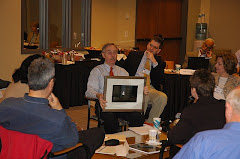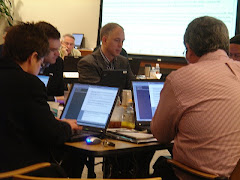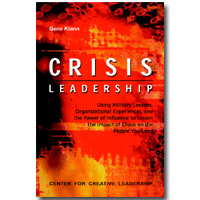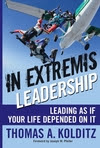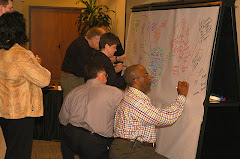 By Pete HammettPete Hammett was one of the discussants in the Crisis Leadership Forum. He's the author of Unbalanced Influence.
By Pete HammettPete Hammett was one of the discussants in the Crisis Leadership Forum. He's the author of Unbalanced Influence.“The practice of leadership is not the same as the exercise of power” -- James Macgregor Burns
“History proves out time and again that a leader mistaken in their thinking and ill-conceived in their decisions will have little trouble finding those ready to agree and wholeheartedly willing to follow.” -- Unknown
The mission of Center for Creative Leadership (CCL) is to promote the understanding, practice and development of leadership for the betterment of society worldwide. And yet, on August 29, 2005, when the Katrina crisis unfolded, those of us at CCL, like many others around the world, struggled to find a meaningful way to show our support. It wasn’t simply the images we saw or the stories we heard that pulled at our hearts. We had friends, business partners and customers who were directly impacted by the storm. Then, in October 2007, when the fires raged in Southern California, events hit much closer to home. The Center has family in San Diego - a campus of nearly 50 people plus adjunct faculty and coaches. And then the long, dry summer of ’07 brought many of us in the Southeastern states the real possibility that sever drought would require some communities to truck in water.
As we observe crisis like Katrina and experience firsthand events like the California fires, we come face to face with the promise and shortcomings of leadership during times of stress, uncertainty and personal tragedy. In this we’ve come to believe that in light of what we’ve come to characterized as crisis leadership, certainly there is expertise CCL could lend and knowledge we might gain by committing our time and energy to this topic. While few events will match the scope and scale of the devastation wrought by Katrina, there are principles and practices we could learn about the nature of a crisis and the kind of leadership needed. So then, if leadership potential can be defined as the ability to learn from lessons-of-experience, the leadership lessons embedded in experiences from Katrina or the California fires or the next crisis on the horizon, offer perhaps the most fertile learning opportunity imaginable.
Our first step in developing a body-of-knowledge in crisis leadership occurred in March 2007 with a two-day forum drawing on lessons from leaders actually engaged in the rescue and recovery efforts from Katrina. In planning for the forum we were sensitive to what had already become an endless series of bureaucratic exercises designed to either assess blame and / or defend positions for the inadequate response to Katrina crisis. To ensure the Crisis Leadership Forum avoided this pitfall we designed the session to be a “conversation” conducted in a safe space, rather than a public forum for an audience. From this we were able to focus on what we could learn from what went right, from what went wrong and what we would carry forward for “the next time”.
As I read through the forum report (Stepping into the Void) my mind raced back to ‘lessons-of-experience’ I heard from those who participated in this exchange. With the benefit of hindsight from Katrina as well as reflection on responding to subsequent crisis events – a few thoughts continue to race through my mind – most haunting are the echoes of “Why doesn’t somebody do something”. I share this with you below.
The Frailty of Crisis Leadership – Self-reliance & Disconnected CommunitiesThe framework of the Crisis Leadership research suggests that in many regards, leadership in times of crisis is not that different from every day leadership, in that we set direction, define strategic objectives, prioritize activities, provide support and foster creativity and innovative. However, during times of crisis, when traditional paradigms fall to the wayside, when a group, community, city or nation is faced with responding to life & death - questions of sustainability or survival greatly influence the manner and method people chose to lead as well as chose to follow.
When the order to evacuate New Orleans came, we saw a great number of people stay in city even with the threat of Katrina looming. Arguments have been made that many stayed because they didn’t believe the storm would be that bad (storms had come and gone in the past, and this one would be the same). But we now know that some residents stayed in New Orleans because they had no option for leaving. While they lived in communities that appeared to be tightly connected – beneath the surface those bonds were very thin and many residents were left to fend for themselves. We observed a similar situation during the ’07 California fires as some homeowners defied orders to leave, even when they saw the danger approaching and had the means to escape.
In these examples are perhaps the greatest barriers to Crisis Leadership, the frailty if you would to leading during times of crisis…our natural instinct for self-reliance coupled with the very thin bonds of connection communities. Perhaps the predisposition to be self-reliant is an American idiosyncrasy. It is part of our nature as Americans to look adversity in the eye and stare it down. But this self-reliance may be the very thing that creates a barrier to building tight-knit bonds within our communities. We may know our neighbor’s name, perhaps what they do and their children. But how tightly connected are our communities?
A post-Katrina analysis looked to compare the impact in New Orleans to that of South Florida in the wake of hurricane Andrew. A Florida resident who survived Andrew offered this word of advice to Katrina victims; “The only thing the residents of New Orleans can honestly count on is themselves. The government isn’t going the help and the city and state won’t be much good. And your neighbors have their own problems. So you’re on your own”.
Leadership is useless unless a leader has those who will follow. During times of crisis, real crisis, a significant barrier to leadership may be followers who lean on self-reliance and communities that are disconnected.
We don’t need another heroAlong with the stories of destruction and lost the media inevitability finds inspiring accounts of compassion, courage and heroics. Sometimes the story involves a single individual – other times it’s an entire community. Yet in these stories there is always a common theme. First, the longer the story is played in the press; the difficult it is to separate myth from fact. This isn’t surprising because in times of distress we need inspiration and hope and over time the stories of heroics take on a life of their own.
However in hindsight we learn a valuable lesson for the role of heroics during times of crisis. While heroics may save the day, heroics will not sustain the future. Heroics are helpful for an isolated event but cannot scale to address a larger community. We can’t replicate heroics nor can we embed heroic events into our crisis plans. Heroics make for great headlines, and we should acknowledge and praise these events. But we seldom offer the same accolades to impactful leadership during a crisis.
The best of times, the worst of timesA lesson-of-experience we heard in the Crisis Leadership Forum is that during a crisis your strengths shine bright and your weakness shine brighter. One organization made this point as they shared how the strength and weakness in their organizational decision making played out in their response to Katrina.
In this organization the mode-of-operation was to enable its leaders to make decisions quickly. In fact, leaders were more likely to be criticized for taking too long to make a decision than for making a poor decision. A by-product of this culture was that decisions often produced less than efficient results. However, in an aggressive growth market a less-than-perfect decision could be make, results analyzed, inefficiencies determine, and fine-tuning applied – generally before the competition analyzed and make their initial decision.
The value and drawbacks in the organization’s rapid yet inefficient decision making culture became crystal clear during the height of Katrina. When several workers became stranded in the city when the levees broke the only evacuation option was a helicopter. With key leaders scattered across several cites and communications difficult, a decision was made and an air evaluation engaged. The decision was quick, but inefficient as not one, but three helicopters brought placed into service because three separate leaders make the same decision.
What truck am I in?One image that has burned in my mind from the Crisis Leadership forum is the image of two trucks.
When Katrina hit some people put whatever ‘extra’ things they had in a truck – drove to an impacted area and said to the survivors standing around “this is for you – I had this sitting in my closet – I hope it helps”. They pushed their ‘stuff’ out of the truck and drove home. They didn’t ask ‘Where do you need this’ or better yet, ‘Where can I help’. This was often referred to as “drive-bys”.
But there were others, who likewise gathered what they had available, put it in a truck and drove to an impacted area. But rather than dumping and running home – they stayed. Some for a few days, others are still there. They found out where the need was the greatest and went there. They gave what they had and when the need was more than what was available they reached out to their networks to get more. But most of all – they gave of themselves, spent real time with those they were serving and in return learned and grew more than they could have imagined.
When I reflect on this story I ask myself…what truck am I in? To be certain there are two types of ‘helpers’ in a crisis:
- Drive-bys…people who put ‘stuff’ in their truck, pull up to people hurting, kick the stuff out of the back, and take off
- Stay-bys…people who put their heart and soul in a truck, pull up to people hurting and stay until the need is met
We need both!!! We’ll remember one.
Why doesn’t somebody do something?With the TV playing the scenes from the Superdome in New Orleans a single thought constantly echoed in room – “why doesn’t somebody do something?” In truth a lot of people were doing something. However the enormity of the crisis overwhelmed every response system imagined. Ironic that the very definition of a crisis is that we are overwhelmed and the systems (people, plans, capacity) to respond are inadequate.
Another irony is that we don’t think about what we could do to help in a crisis until the crisis is upon us. Our friends from the Red Cross offered some great advice for those of who would want to help during a crisis. In as much as you are able, don’t become another soul that needs help. This goes back to where we began – the issue of self-sufficiency. Ignoring danger signs and warnings because you feel you can ‘tough-it-out’ is the dark side of self-sufficiency. However, using your available resources and making plans before a crisis is a helpful approach to self-sufficiency. And it may keep you from being someone who needs help and allow you to be someone who offers help.
A good place to start is the Red Cross’ site on disaster planning.
http://www.redcross.org/services/prepare/0,1082,0_239_,00.html
 As the author James Joyce once said, “Mistakes are the portals of discovery.” And although the leadership failures during and after hurricanes Katrina and Rita pummeled the United States’ Gulf Coast resulted in widespread tragedy, it’s useful to examine what went wrong and to learn what those events can tell us about leadership. In fact, failing to glean lessons from disasters may result in future tragedies that we could have otherwise mitigated. As another author, George Santayana, once wrote, “Those who cannot remember the past are condemned to repeat it.”
As the author James Joyce once said, “Mistakes are the portals of discovery.” And although the leadership failures during and after hurricanes Katrina and Rita pummeled the United States’ Gulf Coast resulted in widespread tragedy, it’s useful to examine what went wrong and to learn what those events can tell us about leadership. In fact, failing to glean lessons from disasters may result in future tragedies that we could have otherwise mitigated. As another author, George Santayana, once wrote, “Those who cannot remember the past are condemned to repeat it.”























